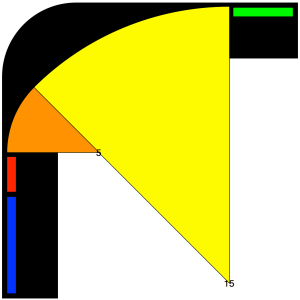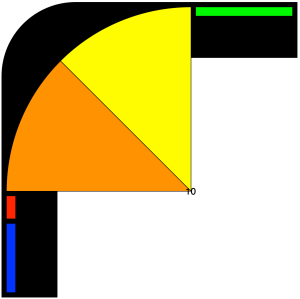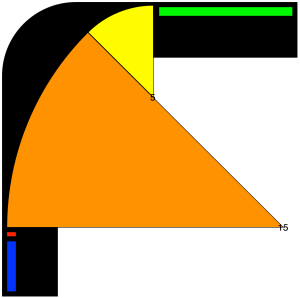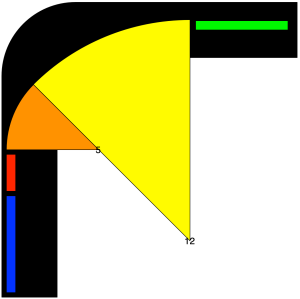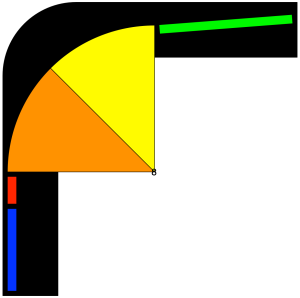One of the things I’ve been curious about for a while is how power and grip affect the optimal racing line. Racers and coaches often talk about the advantages of the late apex line, but how much better is it than other lines? And does it depend on how much power the car has? Or how much available grip there is? In other words, should I change my line if I’m in a Miata vs. Corvette? Or on a asphalt vs. dirt? Let’s find out using a little math.
For this exercise, I’m going to model a corner as having 5 distinct phases. In reality, these all blend together, but I’m separating them to make the math easier.
- Straight (blue). The car is at a fixed velocity on the way into the corner. The length will change depending on the shape of the line, but the speed will not.
- Braking (red). The length of the braking zone is exactly long enough for the car to slow down from the straight speed to the corner entry speed.
- Corner entry (orange). The speed of the 1st half of the corner is determined entirely by its radius and the grip of the tires. There is no trail-braking in this model. In the example above, the radius is 5 units.
- Corner exit (yellow). Again, the speed is entirely determined by the radius of the 2nd half of the corner and the grip of the tires. In the diagram above, the radius is 15 units. In this model, speed changes abruptly between corner entry and exit. For this reason, it is a poor model for very low acceleration vehicles, like bicycles, which can’t speed up much between the two radii. In reality, there is a smooth transition in speed and radius, and the model should be fine for even slow racecars.
- Throttle (green). The speed increase in this zone is determined by the power of the car. The acceleration here is always less than or equal to the grip of the tires.
For this experiment, I’m going to define 5 kinds of racing lines. Most drivers know enough to set up on the outside of the track and cross through the apex (or some apex anyway). So all of these lines do that. But they’re all a little different.
Geometric. The radii of the entry and exit are identical. Corner speed is therefore constant throughout the corner. Despite its ubiquity in driving books, almost nobody drives this line. It’s hardly ever optimal, and serves more as a reference for comparison than anything else.
Late apex. This is the classic racing line where the entry radius is smaller than the exit. Corner speed increases in the 2nd half of the corner.
Early apex. This is generally shunned by instructors but it does have its uses. Corner speed decreases in the 2nd half of the corner.
Rally. This is a form of the late apex line where the entry radius is smaller than the exit radius. But the car does not track all the way to the edge of the track. It sacrifices some speed for safety.
FLA (false late apex). This is a medium radius geometric line that has the appearance of a late apex because the vehicle apexes (runs closest to the inside of the track) after the middle of the turn. However, it does not feature a change in radius and the vehicle does no track all the way out. Most HPDE drivers unintentionally employ this line. Here are several telltale signs: (1) the car ends up in the middle of the track, (2) the driver steers the car to the exit apron (rather than having it drift out), (3) the steering wheel is kept constant throughout the corner, (4) the throttle is not applied until well after the apex (5) if the throttle is applied aggressively too soon, RWD cars spin.
The importance of braking
How long is the braking zone? That depends entirely on the orange radius. That’s right, your braking strategy is determined by the radius of the corner entry. If you arrive too fast, your car will slide into a larger radius, which will ruin your corner, and could send you off track. If you arrive too slow, you will lose precious tenths of a second. Attempts to make up for your error might find you making matters worse in the 2nd half of the corner.
Most drivers talk about where they start braking. Some (fast ones) talk about where they stop braking. I’m going to suggest an alternative. Perhaps the most important point of discussion is how to arrive at the exact speed for the intended radius. If you can do that, you have a chance of driving the corner optimally. How you practice that is the topic for another day. But what should the intended radius be? In other words, what’s the fastest line through the corner? I’ll show the numbers next week. For this week, let’s just appreciate that the fastest line depends on accurately setting your entry speed.
